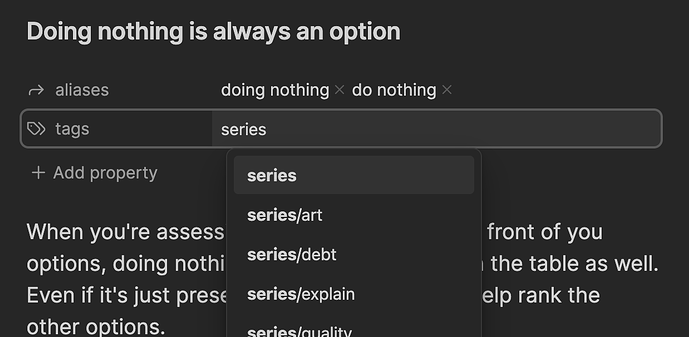I believe organisation in your mind should govern your choice for organisation in your vault. What I mean with this is that I think you should let how you think about notes in your vault should give you guidance as to what you want to use as MOCs or not. Then it becomes a matter of how do you think about your notes, and what is the taxonomy you want to use? I’m going to present a very limited set of alternatives, but please feel free to ask more about that which intrigues you.
No taxonomy, just random links
There is no issue with creating entry points, or MOCs, purely based upon your own links, in whatever format you want. This could be multi-level lists of links, natural passages of text with links, or whatever suits your style the best.
The key point would to consider could be something like: If I enter this MOC, what will be the best structure for me to easily continue finding my way in to that particular subject/topic?
A possible downside with this approach is that it’s hard to automate structuring those notes not belonging to either of your established MOCs, and you’re left with pure searches to find other links to include, if they don’t easily lend themselves to be included during other browsing of your vault.
Heavily dependent on taxonomy
In this kind of scheme, you use properties, tags or whatnot to classify your notes according to some major principles, stuff like PARA, ACE, Zettelkasten, …, or something define by yourself. Personally I try to add type properties to notes, i.e. journals, references, trips, and so on, and for some broader areas I use folders to some extent, i.e. I’ve got folders for Obsidian forum related, Github, journals, etc. I try to use pure tags only for intermediate stuff to help me focus on what to do somewhere within my vault, or for loose topic connections.
The point being that marking up your documents will later on allow you to use queries in various variants to gather up stuff belonging to different areas of interests. Now a MOC becomes a place for those gatherings of links to be organised.
Using a given scheme then would allow you to easily(?) find what belongs in a MOC, and then you can organise the links possibly even my manually sorting them into some list structure which makes sense to you. And since you’re classifying your notes, you could run searches/queries to help you locate stuff you’ve not included in your MOC so far.
An intermediate between these two
I’ve not got all in for either method, as I don’t have the motivation or energy to go for that all including taxonomy which should cover it all in the perfect sense of it all, but I still like to keep some sort of structure.
So for me it’s a matter of convenience as to what is marked up in various ways, and what’s just stored in whatever structure I happened to want for that particular note. I do however try to keep my “main” notes somewhat structured, so that I could do some automatic querying and relation building on them.
So to answer your questions. No you don’t need to master dataview, but it can come in handy to do some searches in various contexts. And the more taxonomy you apply to your notes, the more useful it’ll become as it can help you stay organised.
Is there are a simple way to link or tags notes to appear in a MOC? Well, if you use a direct link in a note to a MOC of your choice, it’ll appear in the backlinks of that MOC. I would then suggest adding a query to your MOC displaying the difference between outlinks of your MOC, compared to the inlinks to your MOC. That query would then show “missing” links from your MOC, where you’ve classified a note to belong to this MOC by that direct link.
An example of this latter query, can be found in this forum, and I’ll look around for it later today (hopefully). Kind of busy, so I’ve got to run now.

